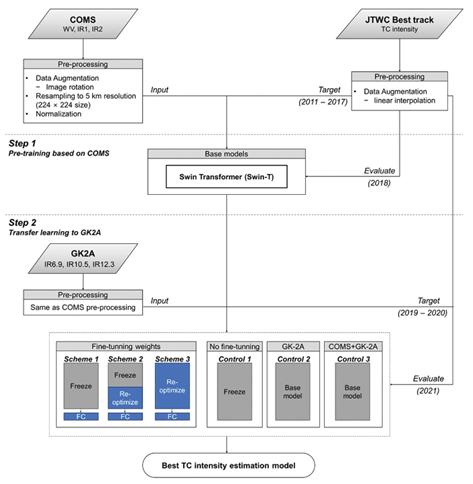Abstract 1:Geostationary satellites are valuable tools for monitoring the entire lifetime of tropical cyclones (TCs). Although the most widely used method for TC intensity estimation is manual, several automatic methods, particularly artificial intelligence (AI)-based algorithms, have been proposed and have achieved significant performance. However, AI-based techniques often require large amounts of input data, making it challenging to adopt newly introduced data such as those from recently launched satellites. This study proposed a transfer-learning-based TC intensity estimation method to combine different source data.
Abstract 2:Tropical cyclone (TC) intensity change forecasting remains challenging due to the lack of understanding of the interactions between TC changes and environmental parameters, and the high uncertainties resulting from climate change. This study proposed hybrid convolutional neural networks (hybrid-CNN), which effectively combined satellite-based spatial characteristics and numerical prediction model outputs, to forecast TC intensity with lead times of 24, 48, and 72 h. The models were validated against best track data by TC category and phase and compared with the Korea Meteorological Administrator (KMA)-based TC forecasts ….
Amidst the challenges posed by climate change in predicting typhoons, a team of researchers has developed a technology that leverages real-time satellite data and deep learning capabilities to predict typhoons with greater precision.
Led by Professor Jungho Im in the Department of Civil, Urban, Earth and Environmental Engineering at UNIST, the research team has unveiled a deep learning-based prediction model that combines geostationary weather satellite data and numerical model data in real-time.

Figure:Communication, Ocean, and Meteorological Satellite Meteorological Imager (COMS MI) and GEO-KOMPSAT-2A advanced Meteorological Imager (GK2A AMI) channels-based observations on 10/22/2019 12:00 UTC for typhoon bualoi (2019) and brightness temperature (BT) distributions of each sensor. The statistics of each observation (minimum, maximum, mean, median, and mode) are represented within the histogram (unit: K).
The Hybrid-Convolutional Neural Networks (Hybrid-CNN) model, proposed by the research team effectively combines satellite-based spatial characteristics and numerical prediction model outputs to objectively and accurately forecast tropical cyclone (TC) intensity with lead times of 24, 48, and 72 hours. The Hybrid-CNN model demonstrates a significant reduction in uncertainty associated with numerical models, thereby enabling more accurate typhoon forecasting.

Figure:Overall flow chart of the proposed transfer learning-based tropical cyclone (TC) intensity estimation model.
The traditional method of observing typhoons relies heavily on geostationary satellite data analyzed by forecasters; however, this approach is hindered by the need for lengthy analysis times and the uncertainty inherent in numerical models. In contrast, the Hybrid-CNN model significantly reduces uncertainty associated with numerical models, thereby enabling more accurate typhoon forecasting.
The research team employed a transfer learning model to estimate TC intensity using satellite data from the Communication, Ocean, and Meteorological Satellite (COMS) launched in 2010 and the GEO-KOMPSAT-2A (GK2A) launched in 2019. The AI visualized and quantitatively analyzed the automatic typhoon intensity estimation process to increase the accuracy of typhoon forecasts.
Environmental factors affecting changes in TC intensity can be objectively extracted and applied to the field forecast system. It is expected that this technology will provide significant assistance in disaster preparedness and damage prevention by providing quick and accurate typhoon information to forecasters.

Figure:Schematic image, showing the explainable deep learning-based tropical cyclone intensity forecasting.
Professor Im stated, “Our deep learning-based typhoon prediction framework will enable forecasters to develop quick and effective measures by providing more accurate prediction information.” The study received support from the Ministry of Ocean and Fisheries (MOF), the Ministry of Science and ICT (MSIT), and the Institute for Information & communication Technology Planning & evaluation (IITP). The findings have been published in GIscience & Remote Sensing and iScience, peer-reviewed journals from Cell Press, in March and May 2024, respectively.
Source:
Unist News Center
Provided by the IKCEST Disaster Risk Reduction Knowledge Service System
Comment list ( 0 )
